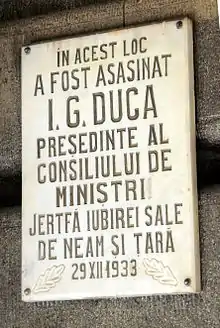Ion G. Duca
Ion Gheorghe Duca (Romanian pronunciation: [iˈon ˈduka] ⓘ; 20 December 1879 – 29 December 1933) was Romanian politician and the Prime Minister of Romania from 14 November to 29 December 1933, when he was assassinated for his efforts to suppress the fascist Iron Guard movement.
Ion Gheorghe Duca | |
|---|---|
 | |
| President of the Council of Ministers | |
| In office 14 November 1933 – 29 December 1933 | |
| Monarch | Carol II |
| Preceded by | Alexandru Vaida-Voevod |
| Succeeded by | Constantin Angelescu |
| Minister of Foreign Affairs of Romania | |
| In office 19 January 1922 – 29 March 1926 | |
| Prime Minister | Ion I. C. Brătianu |
| Preceded by | Gheorghe Derussi |
| Succeeded by | Ion Mitilineu |
| Personal details | |
| Born | 20 December 1879 Bucharest, Romania |
| Died | 29 December 1933 (aged 54) Sinaia train station, Prahova County, Kingdom of Romania |
| Resting place | Horezu |
| Political party | National Liberal Party |
| Alma mater | University of Paris |
Early life
Duca was born in Bucharest on 20 December 1879. He was initiated into Freemasonry while he was studying in France.[1] He completed his studies at the University of Paris, earning a doctorate in law in 1902. As part of a group of professors, physicians, soldiers and other professions, he helped bring scouting to Romania (see also Cercetașii României).
Political career
Duca entered Romania's Chamber of Deputies for the National Liberal Party in 1907. He served in the cabinet from 1914, and was appointed Minister of Foreign Affairs in 1922. He was an avid supporter of the Little Entente, formed between Romania, Yugoslavia, and Czechoslovakia to fend off Hungarian irredentist claims (Hungary claimed Transylvania and the Banat, which Romania gained after World War I) and prevent the House of Habsburg from returning to power in Central Europe.

In November 1933, King Carol II asked Duca to head the government as prime minister in preparation for the December elections.
In this capacity, Duca worked to keep in check the rising support for the Iron Guard, also known as Legion of the Archangel Michael, a fascist movement led by Corneliu Zelea Codreanu, even outlawing the Everything For the Country Party, its political arm. What followed was a time of violence when police on orders from Duca sometimes attacked Iron Guard members[2] (which led to the deaths of 18 of the members),[2] and jailed thousands of them. Shortly after, many of the Iron Guard members were released from jail.
Assassination

On 29 December 1933, just 45 days into his prime ministership, Duca was summoned to Peleș Castle, in Sinaia, for consultations with the king. On the return trip, at night, Duca was shot to death on the platform of the Sinaia train station.[3] This was done in revenge for the actions taken by Duca against the Iron Guard,[4] and because he had allowed for increased Jewish immigration while blocking that of Aromanians to Dobrudja. Duca's assassination was the first major political assassination in Romania since 1862.
Duca was assassinated by three Iron Guard members,[5] that formed the Nicadori Iron Guard death squad, comprising Nicolae Constantinescu, Ion Caranica, and Doru Belimace.[3] All three were arrested straight away and sentenced to hard labour for life. They were all killed, as were many other Iron Guard leaders, on 30 November 1938 while being transported to Jilava Prison.
Legacy
Duca wrote extensive memoirs about his experiences as a cabinet minister during World War I. His son, George, edited Duca and George's memoirs while at the Hoover Institution at Stanford University in the 1970s and 1980s.
There are streets named after him in Bucharest, Constanța, Craiova, Eforie, Mediaș, and Otopeni, as well as a gymnasium in Petroșani.[6]
References
- Ilustri Franc-Masoni Romani
- Jelavich, p.206
- Plăiașu, Ciprian. "Asasinarea lui Ion Gheorghe Duca". Historia (in Romanian). Retrieved 27 March 2021.
- Ornea, p.298; Veiga, p.197–198
- “Taming the Body”: Preliminary Considerations Regarding the Legionary Work Camps System (1933–1937) Valentin Săndulescu, p.87
- "Școala gimnazială I.G. Duca Petroșani". igducapetrosani.ro (in Romanian). Retrieved 30 July 2021.
External links
- Hoover article 1
- Hoover article 2
- Newspaper clippings about Ion G. Duca in the 20th Century Press Archives of the ZBW
